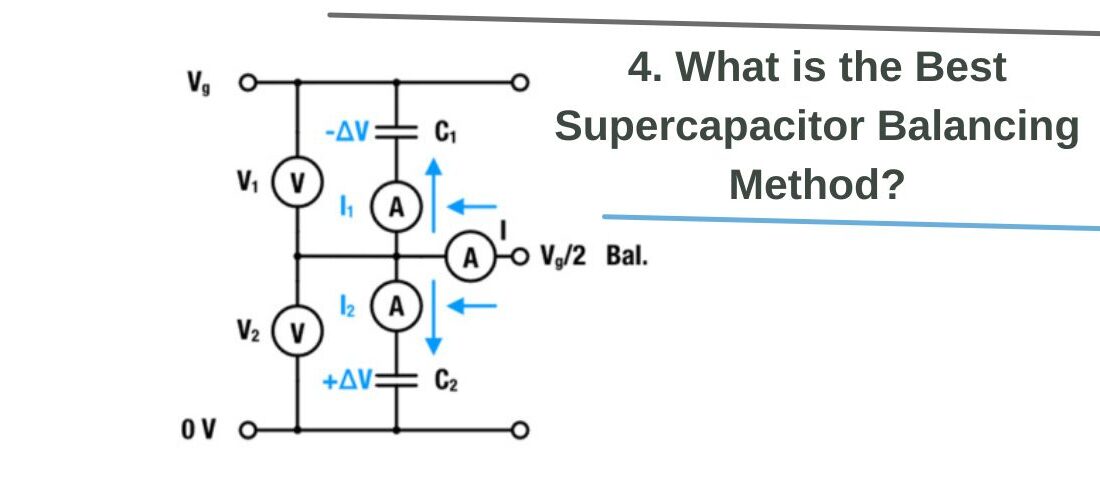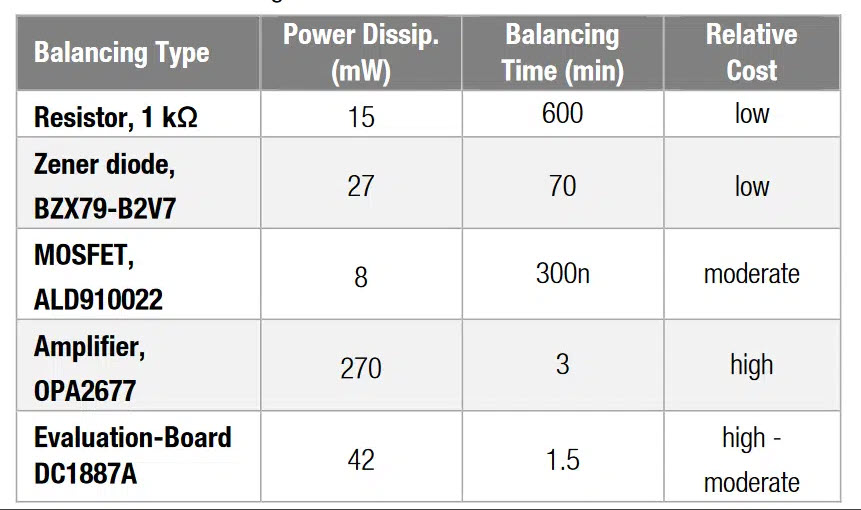
What is the Best Supercapacitor Balancing Method ?
- Posted by doEEEt Media Group
- On February 9, 2023
- 0
We have reviewed the theoretical description of active and passive balancing strategies and performed some practical measurements to illustrate the different characteristics of each strategy.
In the following, we assess the tested balancing circuits based on balancing speed, power dissipation, and pricing. It is, however, the responsibility of the developer to find the best solution based on even more comprehensive parameters. Availability, lifetime, and design-in-time might also influence the choice of balancing strategy.
Balancing with the resistor is the slowest balancing strategy but yields the advantage of low power consumption, low cost, and easy circuit design. Depending on the resistors, it might be suitable for long-term standalone applications. The balancing speed of the Zener diode is moderate. It yields the advantage of relatively low power consumption, low cost, and easy circuit design. The relatively low power dissipation makes it suitable for long-term standalone applications.
The MOSFET circuit showed a relatively low power dissipation. The balancing speed of the given example is moderate. We found the MOSFETs might be suited for long-term standalone applications. Compared to the other strategies, the OP-AMP provides fast balancing but shows the largest power dissipation. Compared to the other strategies, it constitutes the most expensive solution. Due to the high power dissipation, it may not be suitable for standalone applications.
The balancing DC/DC board provided the fastest balancing and moderate power dissipation. It is generally an overall convenient but somewhat pricey solution. Concerning the included DC/DC conversion, its overall cost can be considered moderate. Due to its low power dissipation, it might be suitable for long-term standalone applications.
An overview of the summarized results is given in Table 2.

Table 2: Summary of the results
Literature
[1] F. Beguin und E. Frackowiak (Hrsg.), Supercapacitors Materials, Systems, and Applications, WILEY-VCH Verlag, ISBN: 978-3-527-32883-3, S.352ff (2013)
[2] R. Kötz et al., Principles and applications of electrochemical capacitors, Electrochimica Acta, 45 (15-16), 2483-2498, doi: 10.1016/s0013- 4686(00)00354-6 (2000)
[3] D. Linzen et al., Analysis and Evaluation of Charge-Balancing Circuits on Performance, Reliability, and Lifetime, of Supercapacitor Systems. IEEE-
Transactions on Industry Applications, 41(5), 1135-1141, doi: 10.1109/tia.2005.853375 (2005).
[4] H. Li et al., Synchronized Cell-Balancing Charging of Supercapacitors. IFAC-PapersOnLine, 50(1), 3338–3343, doi:10.1016/j.ifacol.2017.08.518 (2017)
[5] R. Kalbitz et al., Supercapacitor – A Guide for the Design-In Process, Application Note ANP077, WE eiSos (2020)
[6] Y. Qu et al., Overview of supercapacitor cell voltage balancing methods for an electric vehicle, 2013 IEEE ECCE Asia Downunder, doi: 10.1109/ecce-asia.2013.6579196 (2013)
[7] F. M. Ibanez, Analyzing the Need for a Balancing System in Supercapacitor Energy Storage Systems, IEEE Transactions on Power Electronics,33(3), 2162-2171, doi: 10.1109/TPEL.2017.2697406 (2018)
[8] B.T. Prashant Sing et al., Extensive review on Supercapacitor cell voltage balancing. E3S Web of Conferences. 87. 01010.10.1051/e3sconf/20198701010 (2019)
[9] K. B. McAfee et al., Observations of Zener Current in Germaniump−nJunctions, Physical Review, 83(3), 650–651. doi:10.1103/physrev.83.650 (1951)
[10] Link to Supercapacitor Modul in REDEXPERT
[11] Link to Online-Seminar “WE Backup Your Application – A real life Supercapacitor backup solution”
- Space-Grade components available for immediate delivery - April 10, 2025
- Managing EEE components for LEO and lower cost space missions - December 17, 2024
- Filtering Characteristics of Parallel-Connected Fixed Capacitors in LCC-HVDC - November 21, 2024

0 comments on What is the Best Supercapacitor Balancing Method ?